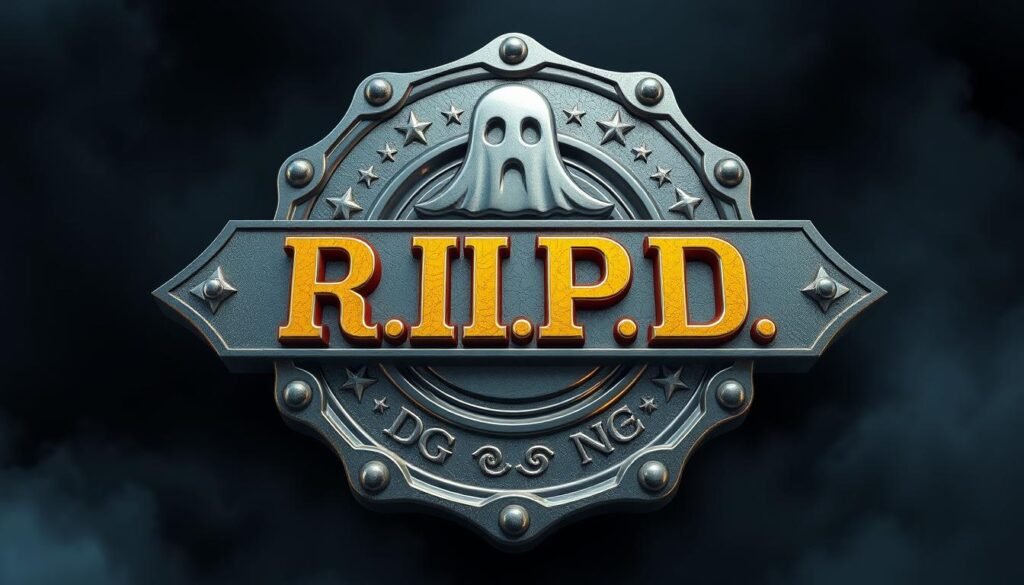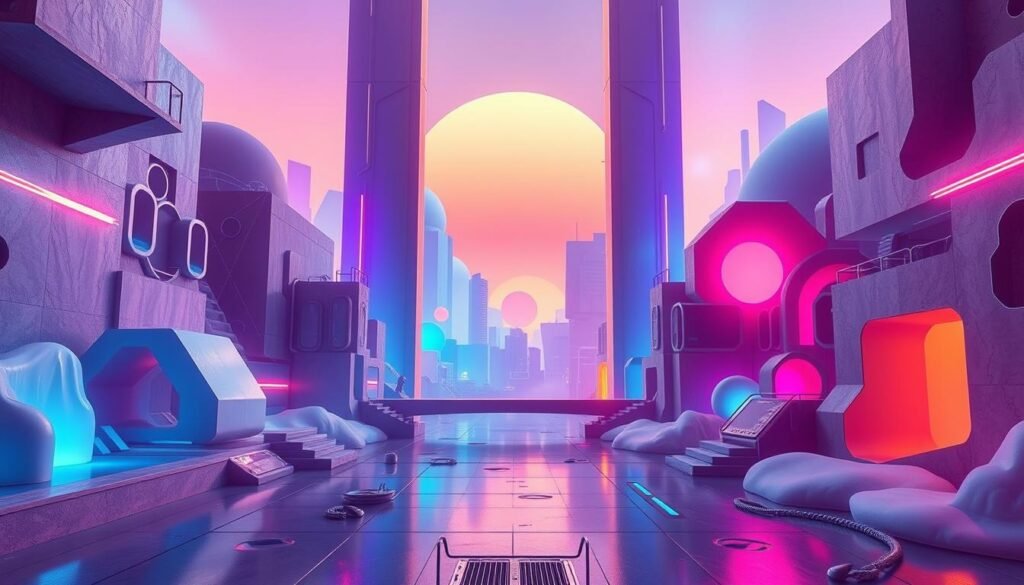The Places Faces logo for THQ is a symbol of top-notch gaming for many gamers. It’s not just on game boxes; it inspires virtual prop replicas too. Like a futuristic gun prop for key art.
Making this logo involved detailed 3D modeling and texturing. It brought the brand’s look to life. The logo fits perfectly with the futuristic look, making a striking virtual asset.
The Places Faces logo’s success shows the power of iconic branding. It has become a true icon in video games. Its influence on virtual prop replicas is undeniable.
The Iconic R.I.P.D. Badge Design Process
The 3D badge design for “R.I.P.D.” was key in the film’s teaser posters. It required careful detail and 3D techniques to come to life. The process involved creating the badge’s unique look step by step.
Step-by-Step Breakdown
The design started with making separate parts like the skull, police hat, and guns. These were then put together using 3D modeling software. The designers used bends and subdivisions to get the badge’s detailed look.
The result was a striking 3D badge that mixed the supernatural and law enforcement themes. The skull, police hat, and guns made a symbol that captured “R.I.P.D.” perfectly.
| Project | Date | Art Direction |
|---|---|---|
| “R.I.P.D. 3D-Logo Icon Design for Key Art” | December 2011 | Gardner DeFranceaux |
| “R.I.P.D. – 3D Virtual Set The White Jailhouse” | September 2012 | Vince Tran |
| “National Treasure Motion Graphics 3D Card Development” | Summer 2004 | Buena Vista Pictures via The Cimarron Group |

The “R.I.P.D.” badge design showed the team’s skill in 3D badge design, product design, prop development, digital sculpting, and visual effects. Their focus on detail and creative methods highlight their commitment to a memorable experience for viewers.
Places Faces Logo THQ: Virtual Set Extensions for Movie Posters
The talented design team at Places Faces had a big challenge. They were tasked with creating virtual set extensions for movie posters. Their goal was to mix 3D digital elements with live-action photos, making the posters more engaging and immersive.
The team used advanced 3D virtual set design to change and improve existing film sets. They made sure the sets fit perfectly for each poster idea. This careful work allowed them to control the details, blending set extension and visual effects seamlessly.
The result was movie posters that combined real photos with digital backgrounds. This mix made the posters more appealing and drew viewers into the movie world. It also built excitement for the films.
| Key Capabilities Showcased | Outcomes Achieved |
|---|---|
|
|

The Places Faces team’s skills in 3D virtual set design and set extension led to stunning movie posters. These posters caught the audience’s attention and promoted the films well. Their creative approach to movie poster design and digital background showed their versatility and dedication to new ideas in poster art.
Illuminati Crest for National Treasure Motion Graphics
The motion graphics in the National Treasure film featured an Illuminati-inspired crest. It was designed as the background for animated text and camera movements. The 3D geometry was detailed with intricate bevels and boolean operations. This gave the crest depth and complexity.
The design included Masonic and occult symbols. These added mystery and symbolism to the motion graphics. The goal was to engage the audience and deepen the intrigue around the Illuminati story.
Creating this crest design was key to the film’s visual tone. The animatic process helped refine the crest’s look. It ensured it blended well with the motion graphics.
The Illuminati-inspired crest was a strong visual element. It represented the film’s themes of the occult and conspiracy. It captivated the audience and left a lasting impression.
Conclusion
The projects in this article show the wide range of logo design and visual effects. From Rainbow Studios’ logo to the R.I.P.D. badge and virtual sets, they highlight the creativity in 3D design. Each project needed careful detail, technical skill, and artistic vision.
Creating a logo, designing virtual props, or making motion graphics is a blend of art and science. The experts behind these works have shown how to mix form and function. Their work proves the impact of logo design, virtual prop development, 3D modeling, visual effects, and motion graphics in engaging audiences.
As technology advances, the need for these skills will grow. This ensures that the visuals we see in movies, games, and media will continue to amaze and stay with us.